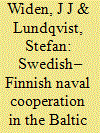| Srl | Item |
| 1 |
ID:
184774


|
|
|
|
|
| Summary/Abstract |
Since Russia’s intervention in Ukraine in 2014, debates about its behaviour and intentions have increased significantly in the West. This article examines Russia’s strategic interests in its historically peaceful Nordic neighbourhood. It identifies and applies the classic strategy terms ends, ways and means in a 100-year perspective and asks if Russia’s military and political goals in the Nordic region have changed after 2014. Despite increased tensions and a more aggressive Russian rhetoric and behaviour, Russian strategic goals in the region are characterised by an evolving continuity and a reluctant acceptance of the current military-political status quo.
|
|
|
|
|
|
|
|
|
|
|
|
|
|
|
|
| 2 |
ID:
148051


|
|
|
|
|
| Summary/Abstract |
Recently, Finland and Sweden decided to substantially deepen their defence cooperation and this project involves creating a bilateral standing Naval Task Group (SFNTG). The present article aims at examining the deepening naval cooperation between Finland and Sweden from a regional integration perspective, focusing on its motives, current challenges and future prospects. Driven by perceptions of common challenges and desires for cost-effectiveness, and strengthened by recent successes on sea surveillance and a combined Amphibious Task Unit, the bilateral project has considerable potential to achieve success. To fulfil its objectives, substantial legal changes in both countries are required to allow the use of force on each other’s territorial waters. To cater for the requirement of not conflicting with EU, NORDEFCO or NATO cooperations, the bilateral Task Group must operate according to NATO standards and by using English as the language in command and control. The costs of adjusting the naval units to NATO’s technical requirements are far from negligible and this issue still remains to be solved. If Finland and Sweden manage to incorporate new policies, common structures and common organisational norms among their navies, an even deeper integration, as in Belgium and the Netherlands, are conceivable.
|
|
|
|
|
|
|
|
|
|
|
|
|
|
|
|